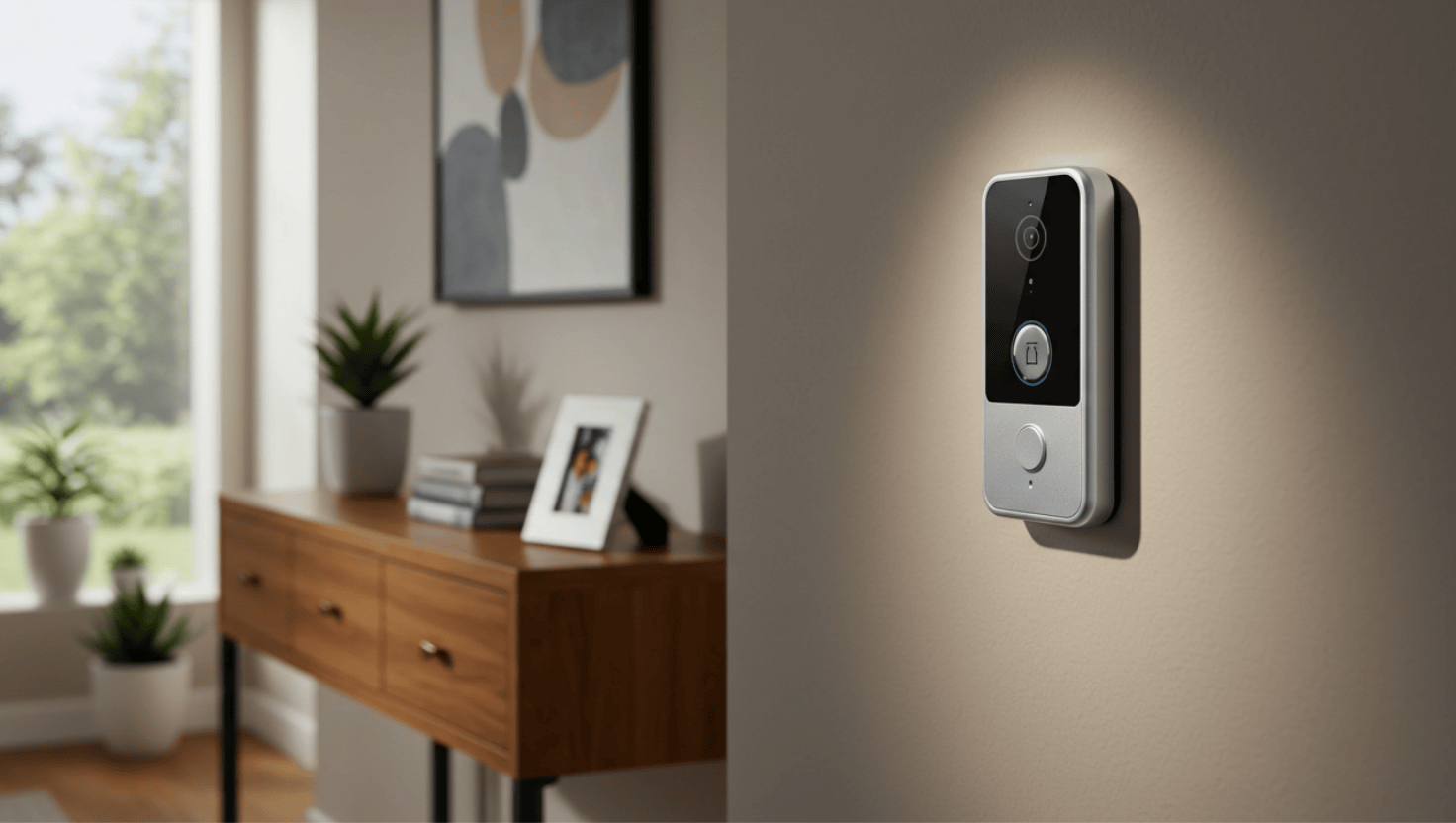
Wireless Smart Doorbells Transform Home Security
Smart Doorbells Guard Your Home
Video doorbell technology stands watch when you sleep. It sees.
It hears.
It warns.
A doorbell camera puts digital eyes on your entrance constantly. No strangers slip by.
No packages vanish. No visitors go unnoticed.
Modern security lives in your hand through smartphone-controlled access and live feeds.
The motion-activated bell catches movement before fingers touch buttons.
You watch everything.
You hear everything. You control everything—from anywhere.
Why Choose Video Doorbell Systems
Remote monitoring systems work when you can't.
They guard your home without breaks. They show faces without opening doors.
They speak when you stay silent.
Homes with video doorbells face 50% fewer break-in attempts.
Criminals spot the camera.
They leave. They seek weaker targets.
Security Benefits
- Real-time alerts let you verify visitors immediately
- Two-way audio enables safe conversation
- Motion detection spots activity others miss
- Night vision maintains protection after dark
WiFi connected entry systems transform doorways into security checkpoints. Check signal strength before installation. Your doorstep security should cover approach paths with clear views.
How WiFi Connected Entry Works
WiFi connected entry systems run on technical foundations you must know. Your doorbell needs the right signal to work when it counts.
Video doorbell technology connects through 4GHz bands rather than 5GHz networks.
The 4GHz wireless smart doorbell signal reaches farther through walls despite offering slower speeds.
This connection delivers the reliability home security camera systems need most.
- 4GHz: Longer range, better wall penetration, broader device compatibility
- 5GHz: Higher speeds, reduced interference, limited range
Doorbell camera systems require specific connection protocols focused on speed rather than bandwidth. The signal strength determines if your motion-activated bell captures visitors or misses them entirely. Most doorbell units work best within 30 feet of routers, though physical barriers reduce effective range.
Test your WiFi signal strength exactly where you'll mount the doorbell before installation.
Wireless smart doorbells must work with your existing network setup. Router position affects your video doorbell performance significantly. Place routers centrally and avoid metal objects that block signals. These basic connection principles enable the remote monitoring benefits that make doorbell cameras worth installing.
For instance, consider the AOSU Doorbell Camera Wireless, which offers real-time alerts and two-way audio for safe conversations. Or the Ring Battery Doorbell known for its advanced features including head-to-toe video coverage and smart alerts.
Staying updated with the latest news and trends in smart doorbell technology can also help you choose the right product for your home security needs.
Connection Troubleshooting
Signal problems happen. Your doorbell camera WiFi connection might drop if too many devices crowd your network. Remove unnecessary connected devices when experiencing visitor notification delays. The technical foundation supports everything else your doorbell does. ## Remote Monitoring Benefits Explained Your front door becomes a command center with remote monitoring capabilities. The technology transforms how you manage visitors from anywhere. Video doorbell systems deliver instant alerts when someone approaches. These real-time alerts reach your smartphone wherever you are, allowing immediate two-way audio intercom communication. Quick responses prevent missed opportunities when dealing with unexpected doorstep security situations.
Package Management Made Simple
Smartphone-controlled access changes how you handle deliveries. The ability to see and speak with delivery personnel through your mobile app control creates protection for packages.
Leave the package behind the planter becomes possible even from thousands of miles away.
- Give specific placement instructions to delivery drivers
- Ask for packages to be hidden from street view
- Verify deliveries happened as requested
WiFi Signal CharacteristicsRemote Monitoring Benefits4GHz offers longer range and better wall penetration | Instant alerts when someone approaches your door |
Doorbells work best within 30 feet of routers | Two-way audio communication with visitors |
Signal strength determines if motion detection works properly | Package delivery management from anywhere |
Router position significantly affects performance | Creates impression someone is always home for security |
Are Smartphone-Controlled Access Systems Secure?
Wireless smart doorbells, such as the GBF Smart Video Door Phone & Doorbell Intercom System, connect through WiFi networks. While smartphone-controlled access systems create potential entry points for digital intruders, they also offer remote monitoring convenience.
End-to-end encryption stands as the first defense against these threats.
Encryption shields your video feed from prying eyes. Think of it like a letter in a locked box. Only you and your doorbell hold the keys. Video doorbell security, like that of the GBF Smart Video Door Phone, depends on this protection to keep footage private.
Cloud storage guards your data behind multiple security layers. But risks remain.
- Company employees with system access
- Government requests for footage
- Vulnerabilities in outdated firmware
Password protection matters more than you think. Create unique, complex combinations for your accounts. Doorbell camera WiFi networks need separate, strong passwords too.
- Update firmware monthly
- Enable two-factor authentication
- Review access permissions regularly
Nothing stands unbreakable. Determined hackers find ways in. Balance convenience with caution when using video doorbell systems. If you're considering enhancing your home security with a smart doorbell, check out these 7 budget-friendly video doorbells that offer essential features without breaking the bank. Moreover, it's worth exploring smart locks for every door which provide keyless entry and remote management options, further enhancing your home's safety and convenience.
Installing Battery-Powered Doorbell Models
Required Tools
Tools gather dust until needed. Battery-powered models require simple DIY setup. You'll need:.
- Phillips screwdriver
- Drill with bits
- Level
- Pencil for marking
- WiFi password
Signal Strength Matters
Signal strength determines reliability.
Test your WiFi connection at the intended mounting location before installation. Doorbell camera performance depends on consistent connectivity. Move your router closer if signal drops below 50%.
Video doorbell placement affects both security coverage and connection quality.
Optimal Positioning
Mount the device 48 inches from the ground. This height captures most visitors' faces clearly with HD camera entry capabilities.
Angle the camera slightly downward using the included angle wedge for better coverage.
Consult the provided template for precise positioning measurements.
Power Management
Battery life typically reaches 3-6 months depending on usage. Features that drain power fastest include:.
- Continuous recording
- High-definition settings
- Frequent motion alerts
- Live view sessions
**False alerts plague many users. **Adjust motion sensitivity in your mobile app control settings if trees or passing cars trigger unnecessary notifications. Create specific activity zones to focus only on important areas for doorstep security monitoring.
Smart Doorbell Security
- End-to-end encryption protects video feeds from unauthorized access
- Battery-powered models typically last 3-6 months depending on feature usage
- Optimal mounting height is 48 inches from the ground for face capture
- Regular firmware updates and strong passwords significantly improve security
Night Vision Technology Comparison
Video doorbell options split between two night vision methods. Infrared sensors see in darkness.
They capture clear footage without any light.
Night vision technology choice matters for home security camera effectiveness.
Different systems handle darkness with unique approaches.
Doorbell positioning makes or breaks night vision performance. Mount your doorbell away from spotlights and street lamps.
Motion-activated bell cameras get blinded by direct light. Weather affects each technology differently.
Rain clouds infrared recordings while fog disrupts color night vision systems.
Technology Performance Differences
- Infrared: Works in pitch black, shows black-and-white images, uses less battery power
- Color: Needs some ambient light, captures identifying details, consumes more power
Properties with long front yards need infrared's greater range. Homes with nearby streetlights benefit from color night vision's detail capture. Package detection works better with color systems when minimal light exists.
Alexa Compatible Doorbell Options
Voice-enabled commands free your hands when visitors arrive. Your voice controls everything. WiFi connected entry systems with Alexa support create whole-home awareness. Smart home integration happens naturally.
Echo Show screens display doorstep security footage instantly. Just say Alexa, show front door and your visitor appears. Remote monitoring begins without touching a device. When someone presses your digital door chime, all Echo speakers announce their presence.
Voice Command Benefits
- Monitor doorbell footage while cooking with messy hands
- Answer visitors using only your voice commands
- Hear announcements through every Echo device
Alexa compatible doorbells unlock powerful routines. Visitor notification can trigger porch lights automatically. Smartphone-controlled access pairs with voice for complete control. Two-way audio intercom works through Echo devices. The system transforms doorbell alerts into whole-home awareness with minimal effort.
Key Facts About Video Doorbell Technology
- Infrared night vision works in complete darkness but produces black-and-white images while consuming less battery power.
- Color night vision requires ambient light but captures more identifying details at the cost of higher power consumption.
- Doorbell positioning away from direct light sources is crucial for optimal night vision performance.
- Alexa-compatible doorbells enable hands-free monitoring through voice commands and can trigger automated smart home routines.
Which Subscription Service Fits You
Video doorbell options boil down to hard truths about what you get. Free plans deliver basics.
Premium services offer real protection.
Free plans give you live viewing and alerts.
Remote monitoring capabilities exist but remain limited.
Cloud storage surveillance disappears quickly—sometimes within hours. Video clips cut short at 10-30 seconds.
You miss what matters.
The truth: Free means forgotten footage.
Paid means protected property.
Premium plans unlock everything essential:.
- Extended video history (30-180 days)
- Complete recordings instead of short clips
- Remote answering from anywhere, anytime
- Package detection and person recognition
Price Tiers and What You Get
Monthly costs run simple. WiFi connected entry systems start at $3 for basic storage. Mid-range plans cost $5-6 with 30-day retention periods. High-end protection reaches $15 monthly. Smartphone-controlled access comes standard across all tiers.
The storage difference matters most:
- Basic: 24-hour cloud storage
- Standard: 30-day video history
- Premium: 60-180 days of footage
Doorstep security improves with better AI. Basic plans alert for any movement. Digital door chime systems with premium features know the difference between cars, animals, people, and packages.
Smart costs more.
But smart saves time.
If you're considering a more affordable option, there are smart doorbells without subscription fees that provide convenience and peace of mind without the added monthly expense.
Choosing Based on Your Property
Property size determines what you need. Battery-powered smart doorbells with basic plans work for apartments. Motion-activated bell technology with 30-day storage fits medium homes. For large properties, premium smart doorbells with multiple cameras and advanced features are a necessity.
Traffic patterns matter too. Busy streets need tamper alarm features and smart filtering. Encrypted video helps reduce false alerts. Visitor notification systems with activity zones focus only on what counts.
HD camera entry systems work best when matched to your specific situation. Small property? Save money with basic service. Multiple entrances? Invest in premium protection.
Plan LevelMonthly CostStorage DurationKey FeaturesBasic/Free | $0-3 | Hours to 24 hours | Live viewing, short clips (10-30 seconds) |
Standard | $5-6 | 30 days | Complete recordings, remote answering |
Premium | $10-15 | 60-180 days | Package detection, person recognition, activity zones |
FAQs (Frequently Asked Questions)
What are the main benefits of using a wireless smart doorbell?
Wireless smart doorbells enhance home security by providing video surveillance and smartphone-controlled access. They offer features like real-time alerts, two-way audio communication, motion detection, and night vision capabilities, making them a valuable addition to any security system.
How do video doorbell systems reduce break-in attempts?
Video doorbell systems have been shown to reduce break-in attempts by up to 50%. This is primarily due to their remote monitoring capabilities, which allow homeowners to keep an eye on their property and communicate with visitors or potential intruders from anywhere via their smartphones.
What should I consider when installing a battery-powered doorbell?
Before mounting a battery-powered doorbell, it's essential to test the WiFi signal strength in the installation area. Optimal positioning is also crucial for capturing faces clearly, ensuring that the camera has an unobstructed view while being away from direct light sources for better night vision performance.
What is the difference between infrared and color night vision technology in doorbells?
Infrared night vision works effectively in complete darkness, providing black-and-white images with low power consumption. In contrast, color night vision requires some ambient light to function but captures more detail in images at the cost of higher power usage.
How can I manage packages delivered to my home with a smart doorbell?
With a smart doorbell, you can see and speak with delivery personnel remotely through your smartphone. This allows you to manage package deliveries efficiently and ensure that they are securely left at your doorstep.
What are the different subscription plans available for video doorbell services?
Subscription plans vary widely. Basic plans typically cost around $3 per month and offer live viewing and limited remote monitoring. Mid-range plans range from $5-6 per month, while premium plans can go up to $15 per month, providing extended video history (30-180 days), complete recordings, remote answering features, and advanced package detection or person recognition capabilities.

